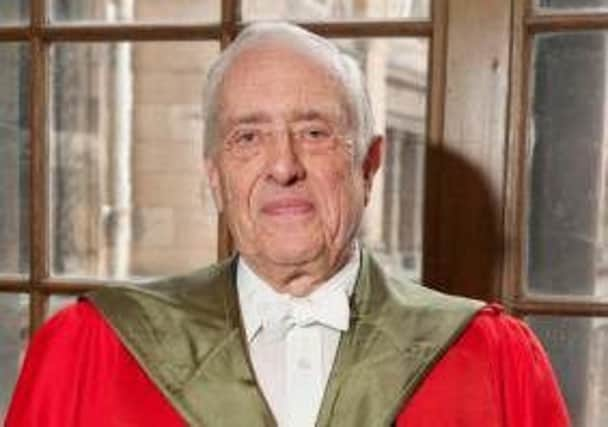Obituary: Professor Evelyn Algernon Valentine Ebsworth


Evelyn Ebsworth came to Edinburgh from Cambridge in 1967 as the inaugural Crum Brown Professor of Chemistry and brought with him fresh and stimulating ideas in both teaching and research to inorganic chemistry.
Together with Charles Kemball and John (now Sir John) Cadogan he established an innovative, competitive and well-balanced School that regained Edinburgh’s world-class reputation in chemistry. His lively sense of humour and skill with puns and literary allusions will be remembered by generations of those he taught.
Advertisement
Hide AdAdvertisement
Hide AdHe was born in Richmond, Yorkshire, on St Valentine’s Day, 1933 and at the age of seven he sailed to South Africa to join his father, Brigadier WA Ebsworth, who was stationed there during the Second World War. He later moved to Southern Rhodesia and Kenya, returning to England in 1945. After attending Marlborough College he went to Kings College Cambridge as Exhibitioner in 1951, to read chemistry, and graduated with a First in 1954.
He then became a research student under the supervision of HJ Emeléus and AG Maddock, and was elected a Fellow of Kings College in 1957.
From 1958 to 1959 he worked with DF Hornig and J Weil, at Princeton University. He was appointed University Demonstrator at Cambridge 1959-64, lecturer 1964-67 and a Fellow of Christ’s College 1959 -67.
At Edinburgh he helped to transform teaching and research by introducing and placing emphasis on the rapidly developing techniques required to determine molecular structure.
A whole new range of modern equipment appeared with impressive rapidity, including high-field nuclear magnetic resonance (NMR), electron diffraction, a photoelectron spectrometer, together with the latest x-ray, infrared and analytical equipment.
His research interests included volatile compounds of silicon and germanium, and their molecular structures; transition metal peroxides; complexes of silicon and germanium with transition metals; complexes of fluorides of P and S(IV) with platinum metals.
His enthusiasm for teaching extended to secondary schools, where he became well known to many local chemistry teachers. In the 1970s, together with Cadogan, he established a very popular series of week-long, in-service summer schools for teachers; many still recall those lively and stimulating events.
Former undergraduates also recall his highly original, inspiring lectures and demonstrations. One involved him climbing onto a bench and jumping down to demonstrate atomic and molecular quantisation. He would exclaim: “I am stable on the bench or on the ground, but not in between!”
Advertisement
Hide AdAdvertisement
Hide AdIn 1984 he became Dean of Science, where one of his main achievements was to transform the teaching of the biological sciences. Hitherto, there had been considerable overlap between the various branches of biological science which, lead to duplication in teaching.
Under his guidance, and not without some controversy, a centralised Biological Teaching Organisation was founded, which lead to a much more efficient use of resources and more coherent teaching.
Ebsworth received numerous honours. He was president of the Dalton Division of the Royal Society of Chemistry; vice-president of the RSC and chairman of its numerous committees. He was given the Main Group Element Award of the RSC and the Kipping Award of the American Chemical Society.
He was elected fellow of the Royal Society of Edinburgh in 1969 and became a very active member. He was awarded a CBE in 1996. In 2013, he was awarded an honorary Doctor of Science (ScD) by the University of Edinburgh “in recognition of his major contribution to Chemistry at Edinburgh”.
He held strong religious beliefs and in 1981 he took part in the BBC2 programme God and the Scientist. He also had a deep love of music, particularly choral music and opera, which frequently led him to performances by Scottish Opera in Glasgow and to the Royal Opera at Covent Garden. Often it was only possible to attend performances at the latter after a day of meetings in London and still catch the last sleeper to Edinburgh, if he ran!
Very sadly, his first wife Mary (née Salter), whom he married in August 1955, died in 1987. This deeply distressed him but with help from his many friends, and particularly Susan and John Mavor, he returned to the demanding role of Dean of Science.
In 1990 he left Edinburgh to become Vice Chancellor and Warden of Durham University, together with his second wife Rose (formerly Zuckerman) – also recently widowed.
During his eight years at Durham the university expanded on many fronts, including with the development of a new campus in Stockton-on-Tees. His humour and commitment made him popular with staff and students.
Advertisement
Hide AdAdvertisement
Hide AdIn the then University Chancellor, Sir Peter Ustinov, he met an equally skilled master of word play. Their repartee during formal visits and graduations became legendary.
After retirement he moved back to Cambridge and served as chairman of the governors of The Leys and St Faith’s schools. In 1998 he was also appointed chairman of the newly established Council for the Registration of Forensic Practitioners. Together with Rose he became a passionate bird watcher, often travelling to distant parts of the world.
He died while travelling in the United States.
He is survived by his wife Rose, four children, five stepchildren and 18 grandchildren. He will be greatly missed by them, and by generations of former students and colleagues.